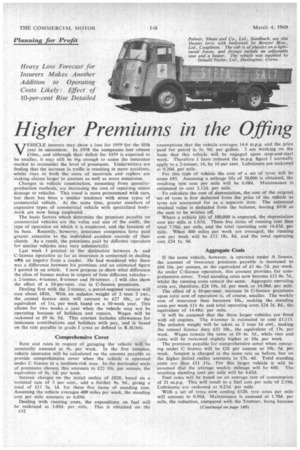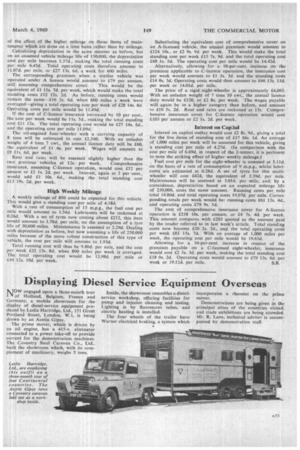Higher Premiums in the Offing
Page 74

Page 81

If you've noticed an error in this article please click here to report it so we can fix it.
VEHICLE insurers may show a loss for 1959 for the fifth year in succession. In 1958 the companies lost almost £10m., and although their deficit for 1959 is expected to be smaller, it may still be big enough to cause the insurance market to reconsider the level of premiums. Underwriters are finding that the increase in traffic is resulting in more accidents, whilst rises in both the costs of materials and repirs are making claims larger in amount as well as more numerous.
Changes in vehicle construction, stemming from quantityproduction methods, are increasing the cost of repairing minor damage to vehicles. This trend is more pronounced with cars, but there has been a similar tendency with some types of commercial vehicle. At the same time, greater numbers of expensive types of commercial vehicle with specialized bodywork are now being employed.
The basic factors which determine the premium payable on commercial vehicles are the value and size of the outfit, the type of operation on which it is employed, and the location of its base. Recently, however, insurance companies have paid greater attention to the individual accident records of their clients. As a result, the premiums paid by different operators for similar vehicles may vary substantially.
Last week I pointed to the distinction between Aand C-licence operation so far as insurance is concerned in dealing wfth an inquiry from a reader. He had wondered why there was a difference between his premium and an estimated figure I quoted in an article. 1 now propose to show what difference the class of licence makes in respect of four different vehiclesa 2-tonner, 4-tonner, 8-tonner and 16-tonner. . I will also show the effect of a 10-per-cent. rise in C-licence premiums.
Dealing first with the 2-tormer, a petrol-engined version will cost about £820. With an unladen weight of 2 tons 2 cwt., the annual licence duty will amount to £27 10s., or the equivalent of I Is, per week based on a 50-week year. This allows for two weeks a year when the vehicle may not he operating because of holidays and repairs. Wages will be reckoned at £9 4s. 3d. This amount includes allowances for insurance contributions and holidays with pay, and is based on the rate payable in grade I areas as defined in R.H.(66).
Comprehensive Cover
. Rent and rates in respect of garaging the vehicle will be nominally assessed at 9s. per week. In the first instance, vehicle insurance will be calculated on the amount payable to provide comprehensive, cover when the vehicle is operated under C licence in a medium-risk area. In the particular scale of premiums chosen, this ambunts to £22 10s. per annum, the equivalent of 9s. Id. per week.
Interest charges on the initial outlay of £820, based on a nominal rate of 3 per cent., add a further 9s. 9dgiving a total of £11 3s. Id. for these five items of standing cost. Assuming the vehicle averages 400' miles per week, the standing cost per mile amounts to 6.69d.
Dealing with running costs, the expenditure on fuel will be reckoned at 3.09d. per mile. This is obtained on the r.32 assumptions that the vehicle averages 14.4 m.p.g. and the price paid for petrol is 3s. 9d. per gallon. I am working on the basis that this vehicle will be engaged upon stop-and-start work. Therefore I have reduced the m.p.g. figure I normally apply to a 2-tanner, 16, by 10 per cent. Lubricants are reckoned at 0.20d. per mile.. For this type of vehicle the cost of a set of tyres will be some £85. Assuming a mileage life of 30,000 is obtained,. the resulting tyre cost per mile will be 0.68d. Maintenance is estimated to cost 2.12d. per mile.
To calculate the cost of depreciation, the cost of the original -set of tyres is first deducted from the price of the vehicle as tyres are accounted for as a separate item. The estimated residual value is deducted from the balance, leaving £630 as the sum to be written off.
Where a vehicle life of 100,000 is expected, the depreciation cost per mile is 1.67d. These five items of running cost thus total 7.76d. per mile, and the total operating cost 14.45d. per mile. When 400 miles per week are averaged, the running cost per week will be £12 18s. 8d. and the total operating cost £24 Is. 9d.
Aggregate Costs
If the same vehicle, however, is operated under A licence, the amount of insurance premium payable is increased to £66 10s. per annum, or the equivalent of £1 6s. 7d. per week. As under C-licence operation, this amount provides for comprehensive cover. Total standing costs now become £12 Os. 7d., whilst the running costs remain the same. Aggregate operating costs are, therefore, £24 19s. 3d. per week or 14.98d. per mile.
The effect of a 10-per-cent. increase in C-Licence premiums upon total cost of operation is, of course, smaller. The weekly cost of insurance then becomes 10s., making the standing costs per week £11 4s. and total operating costs £24 2s. 8d., the equivalent of 14.48d. per mile. .
It will he assumed that the three larger vehicles are fitted with oil engines. The 4-tonner is estimated to cost £1,115. The unladen weight will be taken as 2 tons 14 cwt., making the annual licence duty £32 10s., the equivalent of 13s. per week. Wages remain the same at £9 4s. 3d., while rent and rates will be reckoned slightly higher at 10s. per week.
The premium payable for comprehensive cover when operating under C licence will be £26 per annum or 10s. 5d, per week. Interest is charged at thc same rate as before, but on the higher initial outlay amounts to 13s. 4d. Total standing costs are thus 111 Us. For this larger vehicle it will be assumed that the average weekly mileage will be 600. The resulting standing cost per mile will be 4.62d.
Fuel costs will be based on an average rate of consumption of 21 m.p.g. This will result in a fuel cost per mile of 2.I9d. Lubricants are reckoned at 0.23d. per mile.
With a set of tyres now costing £120, tyre costs per mile will amount to 0.96d. Maintenance is assessed at 1.70d, per mile, the reduction, compared with the 2-tonner, being because (Continued on page 149) of the effect, of the higher mileage on those items of maintenance which are done on a time basis rather than by mileage. Calculating depreciation in the same manner as before, but on an assumed vehiclemileage life-of 150000, the depreciation cost per mile becomes 1.37d., making the total running costs per mile 6.45d. Total operating costs therefore amount to 11.07d. per mile, or £27 13s, 6d. a week for 600 miles.
The corresponding premium when a similar vehicle was operated under A licence would amount to £79 per annum, still assuming comprehensive cover, This would be the equivalent of £1 I Is. 7d. per week, which would make the total standing costs £12 12s. 2d. As before, running costs would remain the same-£16 2s. 64. when 600 miles a week were averaged-giving a total operating cost per week of £28 14s. 8d. Operating costs per mile would be I I.49d.
If the cost of C-licence insurance increased by 10 per cent., the cost per week would be Its. 5d., making the total standing cost £11 12s. The total operating cost would be £27 14s. 6d., and the operating cost per mile 11.09d.
The oil-engined four-wheeler with a carrying capacity of 8 tons will be estimated to cost £2,540. With an unladen
weight of 4 tons 7 cwt., the annual licence duty will be £60,•the equivalent of fl 4s, per week. Wages will amount to
£9 Ils. 6d. per week.
Rent and rates will be assessed slightly higher than the two previous vehicles at 12s, per week. Comprehensive insurance, assuming C-licence operation, would cost £52 per annum or £1 Is. 2d. per week. Interest, again at 3 per cent., would add £1 las. 6d., making • the total standing cost E13 19s. 2d. per week.
High Weekly Mileage
A weekly mileage of 800 could be expected for this vehicle. This would give a standing cost per mile of 4.18d.
With a .rate of consumption of 13 m.p.g., the fuel cost per mile would amount to 3.54d. Lubricants will be reckoned at 0.26d. With a set of tyres now costing about £212, this item would amount to 1.78d. per mile, on the assumption of a tyre life of 30,000 miles. Maintenance is assesSed at 2.29d. Dealing with depreciation as before, but now assuming a life of 250,000 miles because of the more robust construction of this type of vehicle, the cost per mile will amount to 1.93d.
Total running cost will thus be 9.80d. per mile, and the cost per week £32 13s. 8d. when 800 miles per week is averaged. The total operating cost would be 13.98d. per mile or £46 12s. 10d. per week. Substituting the equivalent cost of comprehensive cover on an A-licensed vehiele, the animal pre.mium would amount to £124 10s., or £2 9s. 9d. per week. This would make the total standing cost per week £15 7s. 9d. and the total operating cost £48 Is. 5d. The operating cost per mile would be 14.42d.
Alternatively, allowing for a 10-per-cent. increase on the premium applicable to C-licence operation, the insurance cost per week would amount to £1 3s. 3d. and the standing costs £14 Os. 3d. Operating costs would then amount to £46 13s. I ld. per week or 14.01d. per mile.
The price of a rigid eight-wheeler is approximately £4,065. With an unladen weight of 7 tons 10 cwt., the annual licence duty would be £120, or £2 8s. per week. The wages payable will again be in a higher category than before, and amount " to £10 5s. 2d. Rent and rates are reckoned at 13s. Comprehensive insurance cover for C-licence operation would cost £103 per annum or £2 ls. 2d. per week.
Interest on Cap:tal
Interest on capital outlay would cost £2 8s. 9d., giving a total for the five items of standing cost of £17 16s. Id. An average of 1,000 miles per week will be assumed for this vehicle, giving a standing cost per mile of 4.27d. (In comparison with the cost per mile of 6.69d. in respect of the 2-tonner, it is pertinent to note the striking effect of higher weekly mileage.) Fuel cost per mile for the eight-wheeler is assessed at 5.1 Id. on'the basis of a rate of consumption of 9 m.p.g., whilst lubricants are estimated at 0.28d. A set of tyres for this multiwheeler will cost £424, the equivalent of 3.39d. per mile. Maintenance will be assessed at 3.01d. per mile, and, by a coincidence, depreciation based on an expected mileage life of 250,000, costs the same amount. Running costs per, mile total 14.80d. and total operating costs 19.07d. per mile. Corresponding totals per week would be: running costs £61 13s. 4d., and operating costs £79 9s. 5d.
The cost of comprehensive insurance cover for A-licence operation is £218 10s. per annum, or £4 7s. 4d. per week. This amount compares with £203 quoted as the amount paid by the reader referred to in last week's article. Total standing costs now become £20 2s. 3d., and the total operating costs per week £81 15s. 7d. With an average of 1,000 miles per week, the operating cost per mile would be 19.63d.
Allowing for a 10-per-cent, increase in respect of the premium payable on a C-licensed eight-wheeler, insurance would cost £2 5s. 3d. per week, making the total standing cost £18 Os. 2d. Operating costs would amount to £79 13s. 6d. per week or 19.12d. per mile. S.B.




















































































































